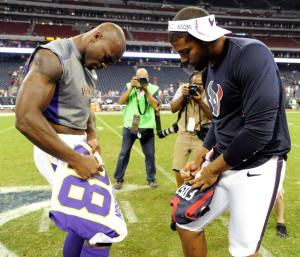[House-keeping note: I’ve added the Salary Cap Calculator to the gray header tabs at the top of each page, so you can now easily get there no matter what page you’re on at Football Perspective.]
A quick look at Arian Foster‘s statistics over the last three years paints a picture of a player in decline:
| Year | G | Rsh | RshYd | RTD | YPC | YPG | C/G | Rec | RecYd | YPR | TD | YScm | RRTD |
|---|---|---|---|---|---|---|---|---|---|---|---|---|---|
| 2010*+ | 16 | 327 | 1616 | 16 | 4.9 | 101.0 | 20.4 | 66 | 604 | 9.2 | 2 | 2220 | 18 |
| 2011* | 13 | 278 | 1224 | 10 | 4.4 | 94.2 | 21.4 | 53 | 617 | 11.6 | 2 | 1841 | 12 |
| 2012* | 16 | 351 | 1424 | 15 | 4.1 | 89.0 | 21.9 | 40 | 217 | 5.4 | 2 | 1641 | 17 |
Foster’s declined in rushing yards per game and yards per carry over the last two years, while his value in the receiving game fell off a cliff in 2012. One could reasonably conclude that Foster simply isn’t the same player he used to be, and that he could drop off even more in 2013. But while the traditional statistics tell one story, what do the advanced metrics say?
According to Football Outsiders, Foster had an outstanding 52% success rate in 2010, but he was successful on only 44% of his carries in 2011. And while his yards per carry average dropped in 2012, his success rate increased to 47% in 2012. That prompted this Nate Dunleavy to argue that based on his success rate, Foster improved in 2012.
On the other hand, his DVOA did take a slight dip, from 2.3% above average in 2011 to -1.6% below average last year. There’s no positive way to spin Foster’s receiving numbers, either. His targets didn’t drop that significantly in 2012, but he produced a pitiful 217 yards. Some of the explanation for the low yardage totals could be that Matt Schaub was checking down to Foster more frequently last year, but that wouldn’t explain why Foster (1) rarely broke a tackle and made a big gain or (2) stopped being an intentional part of the passing game.
Brian Burke’s statistics paint a more pessimistic view. According to Burke, Foster’s Win Probability Added was 1.14 in 2010, 0.14 in 2011, and 0.02 in 2012; even worse, his expected points added has dropped from 52.5 to 6.9 to -23.7 over the same period. Burke’s definition of success rate includes targets, so according to Burke, Foster has declined by that measure as well. Burke views the majority of runs as unsuccessful, so he’s graded Foster’s success rate at 45.8% in 2010, 41.5% in 2011, and a dismal 37.8% (no doubt aided by his poor receiving numbers) in 2012.
But there is some evidence to indicate that Foster the player isn’t declining at all – after all, Burke and Schatz would be the first to tell you that the numbers for Foster are heavily influenced by factors outside of Foster’s control. Pro Football Focus actually argues that Foster has been improving each year. PFF graded Foster at +3.2 as a runner and +10.6 as a receiver in 2010, +6.6 as a runner and +5.6 in the passing game in 2011, and then +9.1 as a runner and -1.5 as a receiver last year. Here’s one explanation for those outlier numbers in the face of diminishing traditional and advanced statistics: PFF ranked the Texans as having the third best run-blocking offense in 2010, the 7th best in 2011, and the 13th best last year.
On the left side of the line, Duane Brown, Wade Smith, and Chris Myers have been constants over the last three years. But the right side has changed significantly since 2010 and 2011, when Mike Brisiel, Eric Winston, and Joel Dreessen blocked for Foster. At right guard, Houston went first with Antoine Caldwell and then Ben Jones, but neither were particularly effective last year. The dropoff at right tackle was even more severe, as Derek Newton wasn’t able to bring anywhere near as much to the run game as Winston. And while Dreesen wasn’t a huge part of the offense, he was a better blocker than James Casey or Garrett Graham.
So are Foster’s traditional numbers declining because the right side of the line has weakened? Not necessarily. The table below shows Foster’s yards per carry on all runs over the last three years, broken down by the direction of the rush attempt per the play-by-play description:
Foster has actually run better to the right side all three years, so I’m not sure how much we can blame the change in personnel. More worrisome would be his struggles up the middle. On 125 carries behind one of the guards or up the middle in 2010, Foster gained 671 yards, for a 5.4 yards per carry average. That dropped to 4.3 in 2011 on 122 carries, and then an abysmal 3.3 average on 137 runs last year.
We can also break down what percentage of Foster’s runs came in which direction:
The Texans did call fewer runs to the right last year, and wisely are running more frequently behind their All-Pro left tackle. From the data, it’s tough to say whether the play-calling, Foster himself, or the lineman are responsible for the decline in production over the last couple of seasons. Part of it is undoubtedly regression to the mean, as expecting Foster and the Texans to continue to maul teams in the running game was probably unrealistic.

